Meatpacking District, Manhattan
The Meatpacking District is a neighborhood in the New York City borough of Manhattan that runs from West 14th Street south to Gansevoort Street, and from the Hudson River east to Hudson Street.[2][3][4] The Meatpacking Business Improvement District extends farther north to West 17th Street, east to Eighth Avenue, and south to Horatio Street.[5]
Gansevoort Market Historic District | |
 An old meatpacking building converted into a boutique | |
 Meatpacking District  Meatpacking District  Meatpacking District  Meatpacking District | |
| Location | Roughly bounded by West 16th Street to the north; Ninth Avenue, and Hudson Street to the east; Gansevoort Street to the south; and West Street and 11th Avenue to the west Manhattan, New York City |
|---|---|
| Coordinates | 40°44′25″N 74°00′25″W |
| Area | 44 acres (18 ha) |
| Architect | various |
| Architectural style | various |
| NRHP reference No. | 07000487[1] |
| Significant dates | |
| Added to NRHP | May 30, 2007 |
| Designated NYCL | September 9, 2003 |
History
Pre-colonial
A Native American trading station called "Sapohanikan" was on the riverbank, which, accounting for landfill, was located about where Gansevoort Street meets Washington Street today.[6][7] The footpath that led from Sapohanikan inland to the east became the foundation for Gansevoort Street,[8] which by accident or design aligns, within one degree, to the spring and autumnal equinoxes.[9] In recognition of this history, petitions were made to call the 14th Street Park "Saphohanikan Park", although it appears no formal recognition was given.[10]
Initial development
The earliest development of the area now known as the Meatpacking District came in the mid-19th century. Before that it was the location of Fort Gansevoort[lower-alpha 1] and of the upper extension of Greenwich Village, which had been a vacation spot until overtaken by the northward movement of New York City. The irregular street patterns in the area resulted from the clash of the Greenwich Village street system with that of the Commissioners' Plan of 1811, which sought to impose a regular grid on the undeveloped part of Manhattan island.[11]
Construction of residences in the neighborhood – primarily rowhouses and town houses, some of which were later converted into tenements – began around 1840, primarily in the Greek Revival style which was prominent at the time.[11] By mid-century, with Fort Gansevoort replaced by freight yards of the Hudson River Railroad, a neighborhood developed which was part heavy industry and part residential – a pattern which was more typical of an earlier period in the city's history but which was becoming less usual, as industry and residences began to be isolated in their own districts. In the western portion of the neighborhood, heavy industry such as iron works and a terra cotta manufacturer could be found, while lighter industry such as carpentry and woodworking, lumber yards, paint works, granite works and a plaster mill blended into the residential area.[11] At the time of the Civil War the part of the district west of Ninth Avenue and Greenwich Street and above 10th Street was the location of numerous distilleries making turpentine and camphene, a lamp fuel.[12]
After the Civil War
When development began again after the war in the 1870s, the tenor of the neighborhood changed. Since it was no longer considered a desirable area to live in, construction of single-family residences was replaced with the building of multiple-family dwellings, and the continued internal industrialization increased. In addition an elevated railroad line had been constructed through the neighborhood along Ninth Avenue and Greenwich Street, completed in 1869.[11] Additional development began in the 1880s when two new markets began operating in the area. On the old freight yards, the Gansevoort Market (originally the "Farmer's Market"), an open-air space for the buying and selling of regional produce started in 1879, and the West Washington Market, 10 brick buildings used for meat, poultry and dairy transactions, relocated to the river side of West Street in 1884.[11] By 1900 the area was home to 250 slaughterhouses and packing plants,[13] and by the 1920s what had been a neighborhood based on mixture of marketplaces became more tightly focused on meatpacking and related activities – although other industries continued to be located there, including cigar-making, transportation-related businesses such as automobile repair, express services and garages, import-export firms, marine supplies, cosmetics, printing and many others.[11] After decades of debate, the High Line elevated freight line was authorized in 1929 as part of the "West Side Improvement Plan", and the New York Central Railroad completed construction, passing through the neighborhood, in 1934.[11]
Decline and resurgence
The area's decline began around the 1960s as part of the general decline of the waterfront area. Containerization of freight; the advent of supermarkets which changed the distribution pattern for meat, dairy and produce from a locally or regionally based system to a more national one; and the development of frozen foods and refrigerated trucks to deliver them were all factors in this, but meatpacking continued to be the major activity in the neighborhood through the 1970s. At the same time a new "industry", nightclubs and other entertainment and leisure operations catering to a gay clientele, began to spring up in the area.[11]
In the 1980s, as the industrial activities in the area continued their downturn, it became known as a center for drug dealing and prostitution, particularly involving transsexuals.{{cn}{ Concurrent with the rise in illicit sexual activity, the sparsely populated industrial area became the focus of the city's burgeoning BDSM subculture; over a dozen sex clubs – including such notable ones as The Anvil, The Manhole, the The Mineshaft, and the heterosexual-friendly Hellfire Club – flourished in the area. Many of these establishments were under the direct control of the Mafia or subject to NYPD protection rackets. In 1985 The Mineshaft was forcibly shuttered by the city at the height of AIDS preventionism.[14]
Beginning in the late 1990s, the Meatpacking District went through a transformation. High-end boutiques catering to young professionals and hipsters opened, including Diane von Fürstenberg, Christian Louboutin, Alexander McQueen, Stella McCartney, Barbour, Rubin & Chapelle,[15] Theory, Ed Hardy, Puma, Moschino, ADAM by Adam Lippes, and an Apple Store; restaurants such as Pastis—which closed in 2014[16]—and 5 Ninth;[17] and nightclubs such as Tenjune. In 2004, New York magazine called the Meatpacking District "New York’s most fashionable neighborhood".[18]
A catalyst for even greater transformation of the area was the opening in June 2009 of the first segment of the High Line linear park. A former elevated freight railroad built under the aegis of Robert Moses, it opened to great reviews in the District (and in Chelsea to the north) as a greenway modeled after Paris's Promenade Plantée. Thirteen months earlier, the Whitney Museum of American Art had announced that it would build a second, Renzo Piano-designed home at 99 Gansevoort Street, just west of Washington Street and adjacent to the southernmost entrance to the High Line;[19] and on May 1, 2015, the museum opened at this site. These were turning points in the changes experienced by the neighborhood over the first two decades of the 21st century, transforming it from a gritty manufacturing district into a bustling high-end retail, dining, and residential area, as documented by photographer Brian Rose in his 2014 book Metamorphosis.[20]
Preservation
By 2003, out of 250 twentieth-century slaughterhouses and packing plants in the area, only 35 remained.[13]
In September 2003, after three years of lobbying by the Greenwich Village Society for Historic Preservation (GVSHP) and its Save Gansevoort Market Task Force of neighbors and allies, the New York City Landmarks Preservation Commission (LPC) established the Gansevoort Market Historic District.[21] The LPC granted only part of the group's request: the new district excluded the neighborhood's waterfront, and the restrictions associated with the designation did not apply to the 14-story luxury hotel (the Hotel Gansevoort) which opened in April 2004.[13] In 2007 New York State Parks Commissioner Carol Ash approved adding the entire Meatpacking District, not just the city-designated Gansevoort Market Historic District, to the New York State and National Registers of Historic Places.[22] The district was listed on the National Register on May 30, 2007, with 140 buildings, two structures, and one other site included.[1]
Since the historic district was designated, threats to the “sense of place” meant to be preserved have continued to crop up. In 2004, GVSHP led a successful fight against a 450-foot-high proposed tower at 848 Washington Street, just over the district's border, which would have been permitted by a change in Department of Buildings policy.[23] In 2009, developers proposed a glass-walled office tower and retail space for 437 West 13th Street that was larger than zoning allowed. GVSHP strongly opposed the project, as the sense of openness in the area would be diminished and the low-scale character of the neighborhood would be eroded.[24] In the end, the developers were not granted all of the variances that they had hoped for, but a glass tower will be built. In 2013 the New York City Council approved a plan to dramatically increase the size of the Chelsea Market complex — outside the Historic District, but within the National Register District — without sufficiently protecting its unique retail character, over the opposition of GVSHP and neighborhood allies.[25] In 2014, however — in line with the repeated requests of GVSHP and other advocates — the city's Board of Standards and Appeals denied a developer's application for zoning variances to make a planned large building at 40-56 Tenth Avenue (between 13th and 14th Streets) even larger.[24] One visible traditional feature that still remains are streets paved with Belgian blocks, often referred to, erroneously, as "cobblestones".
Gallery
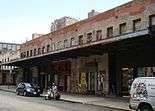 Before gentrification, many meatpacking buildings had become derelict
Before gentrification, many meatpacking buildings had become derelict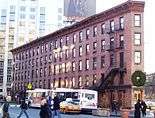 The Herring Safe & Lock Company Building (1849) at the intersection of Ninth Avenue and Hudson Street at 14th Street
The Herring Safe & Lock Company Building (1849) at the intersection of Ninth Avenue and Hudson Street at 14th Street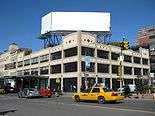 The Apple Store at 14th Street and Ninth Avenue
The Apple Store at 14th Street and Ninth Avenue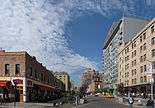 Hotel Gansevoort (right) and Pastis (left) on Ninth Avenue
Hotel Gansevoort (right) and Pastis (left) on Ninth Avenue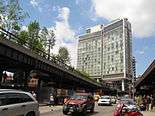 The Standard Hotel above the High Line
The Standard Hotel above the High Line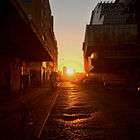 Gansevoort Street is almost perfectly aligned to the Spring equinox
Gansevoort Street is almost perfectly aligned to the Spring equinox
See also
- Chelsea, Manhattan
- Greenwich Village
- High Line (New York City)
- The Standard, High Line
References
Explanatory notes
- Named after Peter Gansevoort, a general in the Revolutionary War
Citations
- "National Register Information System". National Register of Historic Places. National Park Service. March 13, 2009.
- McPherson, Coco (December 24, 2002). "Close-Up on: The Meatpacking District". Village Voice. Archived from the original on August 8, 2007. Retrieved 2008-02-28.
- New York Times map of Meatpacking District
- Mohney, Chris (September 25, 2006). "Close-Up on: The Meatpacking District". Gawker. Archived from the original on January 16, 2008. Retrieved 2008-02-28.
- "Neighborhood - Meatpacking District Official Website". Meatpacking District Official Website. Retrieved 2016-11-21.
- Hudson River Park Trust
- Letter from J. Lee Compton, Chair, City of New York Manhattan Community Board 4 to Kathy Howe (March 8, 2007)
- Bolton, Reginald Pelham. Indian Paths in the Great Metropolis New York Museum of the American Indian, Heye Foundation, 1922. pp58-59
- Earth System Research Laboratory
- "Folkies Sing a Different TuneFor Village’s Chapel Buildin [sic]" New York Observer (February 12, 2001)
- Shockley, Jay "Gansevoort Market Historic District Designation Report part 1" Archived 2012-11-01 at WebCite, New York City Landmarks Preservation Commission (September 9, 2003)
- Johnson, Clint. "A Vast and Fiendish Plot" New York Archive (Winter 2012)
- New York City Names Gansevoort Market a Historic District Archived 2003-10-03 at the Wayback Machine, from the website of the National Trust for Historic Preservation
- Gay, Tim (July 14–20, 2004). "Bring back the beefcake, and add some flowers too". The Villager. Retrieved 2011-08-12.
- Renzi, Jen. "The raw and the cooked: From red light to limelight, New York's meatpacking district redesigns for fashion", Interior Design (4/1/2003)
- Beth Landman (February 26, 2014). "NYC celebs remember iconic Meatpacking eatery Pastis". New York Post. Retrieved April 16, 2015.
- Platt, Adam (May 21, 2005). "Top 5". New York. Retrieved 2012-09-19.
- Steinberg, Jon (August 18, 2004). "Meatpacking District Walking Tour". New York. Retrieved 2008-02-28.
- second
- "Brian Rose Photography". Retrieved 20 August 2014.
- Greenwich Village Society for Historic Preservation Save Gansevoort Market
- Greenwich Village Society for Historic Preservation Meatpacking District Approved for Listing on State and National Register of Historic Places (11 April 2007)
- "Village Group Hails Reversal of City Ruling It Fought". Greenwich Village Society for Historic Preservation. Retrieved 20 August 2014.
- "Final Vote on Zoning Variance". Greenwich Village Society for Historic Preservation. Retrieved 20 August 2014.
- Gray, Billy (January 25, 2013). "Local Residents Fear Food Vendors Will Lose Out in Chelsea Market Expansion". Observer. Retrieved 20 August 2014.
External links

- Meatpacking District Improvement Association website